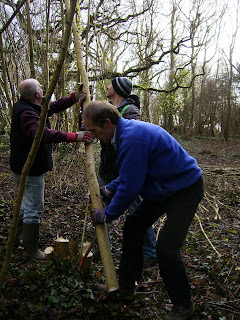Carrie's Pictures.



Eddie's Pictures.




This week saw us at Mill Copse in Yarmouth, helping the rangers Nick and Richard. The route from the car park up to the entrance of the copse was exceptionally muddy, especially following the amount of rain we have had recently. This led us nicely into the first task, which was to spread some limestone chippings on the worst parts of the pathway. The copse was originally ancient woodland, mostly oak and ash with hazel understorey, and the rangers have done a lot of woodland management over the years, involving removal of the conifers planted back in the sixties to allow in more light. This has made the resident ash and oak much healthier, and also encouraged wood anemones and bluebells to grow in the open spaces on the ground. Our second task was to remove some ash trees, and coppice a section of hazel in an area already cleared, which has now regenerated. We also cut up the ash for stakes and used the hazel for heathers (tied up in stacks of 10), to assist with the Hedgelaying Competition being held at Calbourne Mill on Saturday 26 February - a great event for keeping this ancient art alive in the countryside, which is free to attend and well worth a visit! We also made some tree stakes for future planting and, following a request to the rangers, also provided a batch of sticks to be used for Morris Dancing!
Carrie’s Nature Lesson

A plant called “Iris Foetidissima” was found this week, also known as Stinking Iris, one of the two iris species native to Britain. It is found in dry woodlands, hedge banks and scrubby sea-cliffs, mainly on lime-rich soils in southern England. The mauve flowers appear from May to July, and its long strap-like leaves, which form dense evergreen clumps, have an unusual smell when crushed, leading to one alternative name of ‘roast-beef plant’. After flowering the seed pods swell, bursting open in the autumn to reveal spectacular brilliant orange-red seeds, which often stay on the plant throughout winter. It is an excellent plant for a dry,shaded part of the garden, but plant it in free-draining soil that is not too acidic.
Many thanks to Carrie & Eddie for the photographs and text this week.









No comments:
Post a Comment